#russia is a terrorist formation
Text
Four months ago this incredible family was blessed with a beautiful boy Timofey

Today he and his mother Anna were found under the rubble after russian drone attack on Odesa:
This is 3 years old Mark with his mother Anastasia. Tomorrow he could celebrate his birthday:

…but he won’t. His body was found under the rubble this morning. Along with his dad’s. His mother is in critical condition in a hospital.


This is their house in Odesa. One of the hundreds of thousands Ukrainian houses ruined by russia. 8 people killed. Zero military sense, pure terrorism. That’s just what russia does. Every day. For more than 2 years.
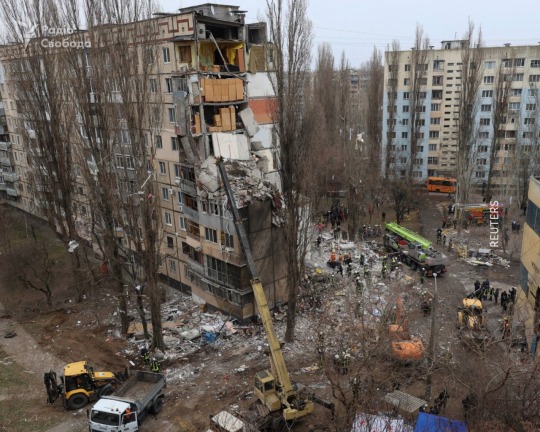
This is Tara. She’s a rescue dog. Today, Tara, along with two other service dogs and rescuers, found the body of a murdered child in the ruins. Tara lay down and cried:
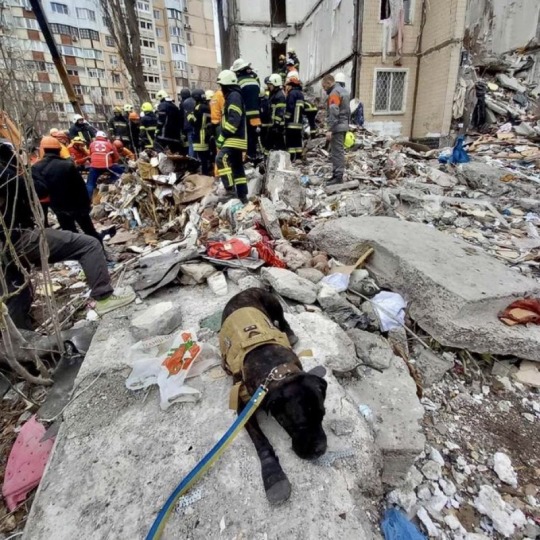
I’d very much want to lay down and cry too. But I can’t. I can’t feel anything anymore. I’m just very very cold.
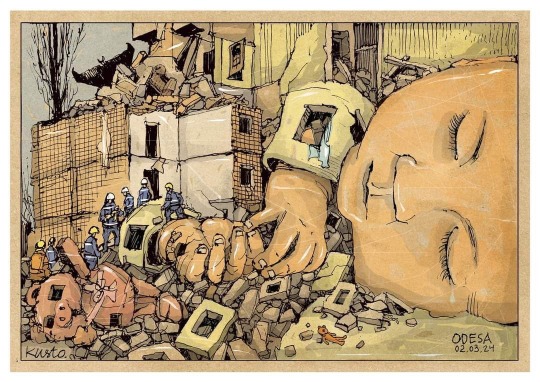
(c) artist Olexiy Kustovskiy
#genocide is russian culture#ukraine#odesa#russia is a terrorist formation#russia commits genocide#never forgive never forget#russia commits war crimes#russia is a terrorist state#russian war crimes#russian war on ukraine#russian invasion of ukraine
285 notes
·
View notes
Text


The Decay of my Fucking Mind, the newest terrorist formation from Russia
#bungo stray dogs#bsd fanart#bsd#nikolai gogol#fyolai#gogsig#sigma bsd#sigma bungou stray dogs#these cretins live in my cranium on NO rent
455 notes
·
View notes
Text
"In his 2002 dissertation, Dr. Pan Yue, the current commissioner of China’s Ethnic Affairs Commission, proposed that a mass migration of 50 million Han people to Tibet and Xinjiang would simultaneously address three major problems confronting China: overpopulation, demand for resources, and the problem of ethnic and religious difference.4 Pan, who became the first non-ethnic minority commissioner of ethnic policy in the history of the People’s Republic of China in 2022, suggested that Han migrants should be considered “reclaimers.” The “backwardness” of the frontier he suggested had become a danger to national security, fostering terrorist and extremist activities. He called on China to learn from a trifecta of contemporary colonizers: the United States, Israel and Russia. Taking elements of each as a model of how contemporary China should further colonize Tibetan and Uyghur lands, he suggests that the Western expansion of settler colonialism in the United States and Russia’s imperial settlement of Siberia, should be combined with the more contemporary example of Israel’s controlled deployment of West Bank settlers and infrastructure in Palestinian lands.
Finally, drawing from a model that draws on China’s post-Maoist legacy of state-managed economy and export-oriented development, and I argue, coincidentally mirroring aspects of the economy that provided a paradigmatic example of racial capitalism, Apartheid South Africa, Pan proposed that minorities should be proletarianized through assigned industrial labor. In his study, it was clear that Pan wanted to combine a land grab with the dissolution of the Maoist system of ethnic minority autonomy within a socialist political and economic system. He was thinking comparatively about the world system of global capitalism not as an object of critique, but as a way of understanding mimetically what China’s place should be with in it.
Part of what this implies, I argue in this book, is that Pan’s “post-ethnic” framework called for the abolition of the limited protections of difference that the Mao era had fostered, and—as to some extent in the U.S., Russia, and Israel—the replacement of civil liberties and autonomous claims for Muslim and Indigenous citizens, with markers of an imagined evil, the figures of the terrorist and the proto-terrorist, the non-secular “backward” other. Recalling Apartheid South Africa’s “color bar,” Xinjiang’s Muslim reeducation and assigned labor system should be thought of as a kind of “Muslim bar,” a legalized racialization of ethno-religious difference that holds in reserve the majority of positions of managerial and ownership power for Han settlers.
Pan was explicitly looking to the capitalist-colonial past and present, because taking this comparative move seriously is also to take seriously China’s position within the global world system. In what follows I will think comparatively with Apartheid South Africa, and the Marxian world systems theory elaborated by Cedric Robinson (1983) and others that emerged from analysis of it, to show that racialization is an essential part of the global process of on-going original or primitive accumulation.5 This suggests that racialization—as an institutionalized process supported by the police, the law, the school system, and so on—is not simply an organic outcome of transhistorical process or an effect of particular political formations.6 On the contrary, it is a historical feature of global capitalism and the imperial economic expropriation—or legalized theft—on which it depends.
Produced as a Terrorist
The account of one of my Uyghur interlocutors, someone I’ll call Abdulla,7 and the way his life path was redirected and shaped by the structural factors I describe above demonstrates what all of this means in everyday life. Abdulla was just one of the dozens of Uyghurs and Kazakhs whose stories shape the narrative of this book. Though many of the other Muslims I interviewed and observed came from lower class positions and had less formal education than Abdulla, many of the things I observed in Abdulla’s story happened to them too. His fast transfer from the camp and unfree labor system to neighborhood arrest and a return to medical school, are the primary differences between him and others. And these differences, which can be directly correlated to his near perfect Mandarin elocution and his practice as a physician’s assistant who was just two semesters away from receiving his degree as a medical doctor, demonstrate how finely graded the system of Muslim racialization and how it is reproduced.
Abdulla, like nearly all Uyghurs I met in the city, came from a rural village in Southern Xinjiang where Uyghurs formed a supermajority of over 90 percent of the population. For his first 18 years, all of his life happened in Uyghur. Then he arrived in the city as a college student and was confronted with world of Chinese. The first born of a village teacher, he knew from a young age that he wanted a life that was different from the farmers he was surrounded by. This is why he poured himself into learning Chinese and English, watching the entire Friends TV show on repeat. He wanted a Uyghur version of that fictitious life. To do this he understood that he had to present as urban and secular, he had to shave his moustache, wear clothes from the Chinese shopping mall, and speak in jocular Chinese with Han colleagues. At the university he studied biology and science in Chinese, preparing for a career in in the Chinese medical system. But at night, he and two other friends from villages near his hometown, studied English. In the space of several years, they became so fluent in American pop culture that they started their own English school training hundreds of other Uyghur villagers to speak the language of American TV and imagine a world outside of both the Uyghur and Chinese one they grew up in.
His students and friends gave Abdulla the nickname “suyok,” meaning he moved like water, flowing effortlessly from one social scene to another, codeswitching, mastering the multiple consciousnesses that are necessary for a minoritized person to succeed in a racialized world. He was a smooth operator. But he was also influential among Uyghur young people, and over time the police began to take notice of him. They sent informants to the night school where he taught to report on things students said and how the Abdulla responded to them. But Abdulla anticipated this, so when he discussed the biography of Nelson Mandela he was careful not to make direct comparisons to the Apartheid conditions that Uyghurs experienced in the city.8 In the private-public space of the classroom they did not discuss the way only around 15 percent of Uyghur college graduates were able to find jobs regardless of how well they spoke Chinese and English.9 Nor did they discuss the stories his students told him privately of the way they had witnessed police brutality and how the same police protected the non-Muslim settlers that had inundated their villages as part of the large-scale migration Pan Yue had called for.
But then in late 2014 three of his students disappeared from their dorm room, leaving behind their belongings. They didn’t tell their families where they were going until several weeks later when they re-emerged in Malaysia at the other end of the underground trafficking route that took them across the hills of Myanmar where they joined North Koreans and Rohingya fleeing state violence. The police questioned Abdulla for days. Abdulla vowed that he had no knowledge of their plan.
That incident, and the arrest of the parents of his students, the way the police began to search Muslim homes on a regular basis, and the new prohibitions on any form of religious speech, made him quite concerned. He started plotting his own escape. Utilizing all of his connections, in 2016 he managed to obtain a passport and visit Europe and me and other friends in the United States, thinking through the logistics of an international move and what it would take to get his medical training recognized abroad. It would be hard he realized, but it seemed like the only path forward. All he had to do was find a way to get passports for his wife and children and sell his apartment in the city. But he never did.
In 2017 he was detained along with hundreds of thousands of other young Uyghurs and sent to a closed concentrated education and training center. His travel history, his association with students who the state now regarded as international terrorists, was more than enough for him to be regarded as untrustworthy. Yet unlike most other detainees, all of whom had similar digital dossiers of thought crimes and “abnormal” behaviors, Abdulla had an advanced degree in medical science, he spoke perfect Chinese and could recite all the laws and regulations related to ethnic policies. If the political and economic goals of the camp system were to train Uyghur villagers to speak Chinese and work in factories, why detain and train someone already working in a Chinese institution?
Fundamentally, Abdulla and the hundreds of thousands of other migrants and farmers had been detained for particular political and economic reasons that had less to do with their past individual actions, though the digital footprint of these actions were collected and assessed, and more to do with their ethno-religious and generational status as young, rural-background Uyghurs. But simultaneously, the cost of producing them as workers was also being externalized to the village communities that had trained them, the families that had sacrificed their livelihoods to send them to school. Even workhouses need doctors. It appears that Abdulla was destined to become a rare Muslim doctor tasked with maintaining and reproducing the system of racialized carceral care. His devalued assigned labor was not in the factory, but for the factory workers and their child. He could never leave the city, instead his future was a permanent state of probation. He could always be sent back to the camp or demoted to the factory or worse.
2017 Xinjiang :: 1972 South Africa?
In many ways, discussion of what has happened in Xinjiang resembles discussions of Apartheid South Africa in the 1970s. Among conservative and liberal proponents of the capitalist world order, both cases are often seen as exceptions rather than limit cases of capitalist logics.
However as radical historians such as Martin Legassick (1984), Walter Rodney (1972), and sociologist Michael Buroway (1974) have demonstrated, South Africa was in fact a capitalist state whose economy centered on the production and reproduction of difference.10 South Africa was a paradigmatic example of a state-managed capitalist order that codified a so-called “color bar” (Buroway 1974, 1054) that excluded black and brown people from certain forms of employment reserved for whites. This exclusion along with processes of removing native peoples from their lands and forcing them into external resource dependent, impoverished reserves resulted in two new modes of production. Subsistence living on reserves and a supply of surplus miners from those reserves. The color bar “fixed” in place the contradiction between capitalism and democratic politics, preventing black South Africans from preserving their own wealth, denying them social mobility in the workforce, and strangling systems of mutual aid.
It was from this example, among others, that scholars such as Cedric Robinson (1983 [1999]) and Mahmood Mamdani (1996 [2018]) began to build a general theory of the way capitalist-colonial development works through the production of difference—rather than homogenizing effect of “all boats rising” as national economies grow as a whole.11 By devaluing the labour and possessions of citizens and non-citizens deemed and legally categorized as different, state-subsidized and supported business interests and settler overseers are empowered to accumulate wealth in a fixed, ongoing manner.
Fast forward five decades and the outlines of a similar “color bar” fix can be seen in motion operating through an anti-Muslim racial regime. As in South Africa, Xinjiang multinational and domestic corporations are deeply invested in maintaining continual growth. The system in Xinjiang relies on a dual mode of racialized capital accumulation in the form of labor and data. In a general sense, the labour theft element of the system relies not only on the theft of the individual worker’s life, but also a theft from the family and community that raised and cared for that worker. By stealing a daughter or son from an Uyghur family and community, the reeducation campaign externalizes the cost of producing an unfree worker. As the state hired 90,000 new non-Muslim teachers with high-school degrees from villages across China, the reproduction of this labor-force was further ensured by a residential school system that would produce the next generation of Uyghur factory workers.
As with Apartheid South Africa, the world is the market for much of the prediction products and consumer goods produced by the unfree workers in Xinjiang. It also participates in the global discourse of anti-Muslim racism. These areas of convergence with the imperial North—through both memetic political relations and a shared global economy—point to the ultimate lesson of Xinjiang. In a world where the power of Chinese corporations and autocrats is unchecked they operate in much the same way as other colonial powers."
-Darren Byler's preface to the simplified chinesse edition of his book "In the Camps", June 2023
24 notes
·
View notes
Text
Conversations about white supremacy in America today typically center on right-wing media and incendiary politicians who blast out racist dog whistles.
But hate doesn’t need demagogues to get mainstreamed; it has also found an outlet at elite universities.
On June 29, Stanford University hosted a delegation from the Azov Brigade, a neo-Nazi formation in the Ukrainian National Guard. The panel, during which Azov’s neo-Nazi insignia was projected onto the wall, was attended by noted political scientist Francis Fukuyama, who posed for a photograph with the delegation.
This event — and the disturbing lack of reaction from Jewish organizations — showcases the limits of America’s commitment to combating white supremacy.
Call it the Ukraine exception.
Before Russia’s 2022 invasion, nearly every Western institution raised alarms about Azov. Putin’s brazen attack on Ukraine led to a much deserved outpouring of support for the country. Unfortunately, it also led to suppression of those who criticize the dark side of Kyiv: its reliance on far-right military elements, the most prominent example of which is Azov.
Even amid today’s surge of antisemitism globally, Azov has become the Teflon Neo-Nazis: freedom fighters who can do no wrong, celebrated across America, including at prestigious institutions like Stanford.
All too often, this adulation of a neo-Nazi formation has been met with silence by the Jewish community.
From neo-Nazis to heroes
Azov began in 2014 as a paramilitary battalion formed out of a neo-Nazi street gang; it helped Kyiv fight back against Russian-backed rebels in eastern Ukraine. Azov eventually grew into a brigade in Ukraine’s National Guard. In addition to committing war crimes, the unit is notorious for its recruitment of radicals from around the world, including America.
Azov’s radicalism has been tracked by the Simon Wiesenthal Center and the Anti-Defamation League, banned as a hate group by Facebook and blocked from receiving weapons by Congress.
But then, Russian president Vladimir Putin used Azov as “justification” for his invasion. Moscow needed to sell the war to the public — it exploited Azov’s existence by falsely painting Ukraine as teeming with fascists and Russia’s invasion as a “denazification” mission.
The reaction of the West played in Azov’s favor. The existence of white supremacists certainly doesn’t give Putin the right to invade Ukraine. The Kremlin’s premise of “denazification” also rings hollow, considering there are plenty of neo-Nazis fighting for Moscow.
But for Azov, Moscow’s obsession has been a ticket to the limelight. Buoyed by the notion that If Putin hates them, they must be the good guys, brigade members have been welcomed to Congress and lauded on television.
In addition to an Azov veteran, the Stanford appearance featured Kateryna Prokopenko, whose husband Denys was the brigade’s commander through the spring of 2022.
Denys Prokopenko has been photographed with his platoon’s informal insignia of a bearded Totenkopf, a type of skull-and-crossbones used by the SS. He was also featured on the cover of Azov’s unofficial magazine, which uses the Sonnenrad neo-Nazi rune favored by white terrorists like the perpetrator of last year’s massacre in Buffalo, New York.
Third Reich insignia on an elite campus
Last week’s event wasn’t Azov’s first Stanford tour – a delegation was also welcomed there last fall. Ironically, one of Stanford’s own institutes published a report chronicling Azov’s white supremacy mere months before the brigade’s visit.
When asked about Azov’s return to campus, a university spokesperson told me via email on June 27 that the event was co-sponsored by the Ukrainian Student Association at Stanford at the Department of Slavic Languages and Literatures. “The university does not take positions on outside speakers that groups within our community want to hear from,” they added.
But Azov’s visit concerns an issue Stanford has taken a position on: Nazi symbolism.
The flyer advertising the Azov event contains the brigade’s official insignia, which is the wolfsangel, yet another hate symbol used by both the Third Reich and today’s neo-Nazis.
This isn’t the first Stanford incident involving Nazi imagery. However, the lack of response on Azov stands in sharp contrast to Stanford’s actions in previous cases.
n 2019, Stanford was embroiled in controversy after left-wing cartoonist Eli Valley was invited to speak on campus. Valley, whose artwork features grotesque satire using Nazi imagery, was met with protests. Indeed, it led to university officials issuing a lengthy statement condemning antisemitism.
This March, the school addressed the discovery of swastikas in a dormitory by stating, “Stanford wholeheartedly rejects antisemitism, racism, hatred, and associated symbols, which are reprehensible and will not be tolerated.”
When more antisemitic attacks followed in April, Stanford’s president said: “I want to make it very clear that we will not tolerate antisemitism and the symbols of antisemitism here on campus. It is something we need to eradicate.”
Yet despite these declarations of commitment to combating antisemitism, Stanford has not responded to repeated inquiries about the university’s position regarding the Azov event displaying the wolfsangel.
We seem endlessly surprised at politicians like Donald Trump who refuse to accept responsibility for actions that enable bigotry. It shouldn’t be surprising, considering demagogues don’t bother with responsibility; that’s what makes them demagogues.
But what about a pillar of education and enlightenment like a prestigious university? What’s Stanford’s excuse?
Calling out neo-Nazism: Void where prohibited
Our tolerance of Azov seems even more alarming when we consider reactions to neo-Nazism that don’t involve the brigade.
In 2018, Rep. Matt Gaetz was caught inviting a Holocaust denier to the State of the Union. Gaetz’s decision to platform hate on Capitol Hill was condemned by colleagues and the ADL.
But there have been no denunciations of numerous lawmakers who welcomed Azov fighters to Washington. This includes Rep. Marcy Kaptur, who was photographed with an Azov veteran whose Twitter contained pictures of him wearing a shirt with 1488 (neo-Nazi code) and “likes” of a Hitler photo and “Death to Kikes” graffiti.
Indeed, Azov delegations to Washington proudly advertise their meetings on the Hill.
Or see how Jewish media and the State Department took the trouble to condemn musician Roger Waters for wearing a fascist uniform during concerts (this is part of Waters’ performance of The Wall, a satire of fascism).
The very same day, The New York Times exposed the prevalence of Nazi symbols in Ukraine’s armed forces, which receive billions in American weapons. You’d imagine this news would be at least as concerning as a musician’s costume. Yet neither the State Department nor Jewish watchdogs reacted to it (and neither the State Department or the ADL have responded to my requests for comment).
The American Jewish community must condemn neo-Nazism without exception, not just when geopolitically convenient. They can start by calling on institutions like Stanford to stop platforming Azov.
35 notes
·
View notes
Text
@staff you need to revise your advertisement policy. At the very least check if the advertiser is not a terrorist.
Why am I, as a Ukrainian, CONSTANTLY seeing an ad from "The brothers of russia in DNR"????

"DNR", or "Donetsk People's Republic", is a formation created by russia in Ukrainian city of Donetsk, after russia invaded it in 2014. Their forces (along with the regular russian army units) are responsible for downing the MH17 Boeing, along with many,many, many war crimes inflicted upon Ukrainians. THEY ARE LITERALLY TERRORIST MILITANTS. WHO TAKE PART IN LITERAL GENOCIDE RIGHT NOW.
GET IT SORTED OUT.
#tumblr#i feel like i should stop using tumblr now... since it's promoting the murderers who want me dead or in a concentration camp
152 notes
·
View notes
Text
The March 22 terrorist attack targeting concertgoers in Moscow, which was later claimed by the Islamic State, was an eerily familiar shock for Russians. In 2002, approximately a year after 9/11, Islamist terrorists claiming allegiance to a separatist movement in Chechnya besieged the crowded Dubrovka Theater in Moscow. More than 130 people were killed in the operation to clear the theater.
Last month’s attack, which killed at least 144 people, opened multiple geopolitical fissures. The Kremlin, having caught—and tortured—at least a few of the suspected perpetrators, claimed that the terrorists were looking to head toward Ukraine, where Russia is embroiled in its own endless war. Online, the story took a life of its own as conspiracy theories overwhelmed facts.
As attention shifted eastward toward the Islamic State-Khorasan (ISK), the group’s branch based in Afghanistan, contrarian views, mostly in Russian media but amplified on social media platforms, of this being a false-flag operation designed by the West simultaneously took off.
In between such distractions, the victor was the Islamic State. The group’s spokesperson, known by his nom de guerre Abu Hudhayfah al-Ansari, released a 41-minute audio message a few days after the Moscow attack. Curiously, the message, titled “By God, this religion [Islam] will prevail,” mentioned Russia only in passing. It however congratulated Islamic State ecosystems and wilayas (Arabic for provinces), or offshoots, on a successful 10 years of the caliphate.
The message takes the listener on a world tour of sorts, highlighting the group’s presence across regions from Africa to Southeast Asia, challenging the notion that it is a spent force. Ansari also congratulated the group’s fighters for their campaigns against the Chinese, Russians, Sikhs, and Hindus. It also chastised the very idea of democracy—a long-standing ideological position for most jihadi groups.
Only a few hours prior to this, ISK had released a separate 18-minute propaganda video in Pashto targeting the Afghan Taliban’s outreach with India. This is particularly noteworthy after India facilitated the evacuation of Sikhs and Hindus from the country, specifically after ISK claimed an attack against a Sikh temple in Kabul in 2022. Islamic State propaganda has also long stoked communal divisions in India to instigate Muslims against the state.
The video took the format of a first-person narrative, discussing how the Taliban regime was working with the Indian state, which ISK views as an anti-Muslim institution. This was not the first time either the Islamic State or ISK had targeted India in its propaganda, but interestingly, the latter’s primary aim here was the Taliban’s behavior and not necessarily India, its democracy, or its perceived Hindu-nationalist political bent by itself.
The chaotic U.S. exit from Afghanistan and subsequent return to power of the Taliban in 2021 was a watershed moment. But the negotiated exit was not a difficult decision for the U.S. government, which was clear in its vision on what it wanted out of leaving, as Washington looked to pivot toward new areas of strategic competition in Asia.
The challenge fell to powers within the region, which were left to deal with an extremist movement in control of a critical neighboring state. For more than 20 years, Afghanistan’s neighbors, including China and Russia, benefited from the expansive U.S. and NATO military umbrella. This allowed them to pursue their own strategic interests such as developing influence within Afghanistan’s ethnic divisions and the power brokers representing these groups without any significant military commitment. On Aug. 30, 2021, then-Maj. Gen. Christopher T. Donahue was the last U.S. soldier to leave the country. Afghanistan was now an Asian problem.
But Russia, China, and Iran—the three primary adversaries of the United States, and by association Western geopolitical constructs—were in fact happy. After two decades, there were no massive U.S. military deployments on Iran’s eastern border at a time when its relations with Washington were at their worst. Tehran’s own history with Afghanistan, and specifically the Taliban, is confrontational.
Throughout the 1990s, the Iranians supported anti-Taliban groups, particularly rebel leaders such as Ahmad Shah Massoud and the Northern Alliance. Tehran was not alone, as others, including India, Russia, and Tajikistan among others, supported these groups against the Taliban and its sponsors in Pakistan.
Fast forward to 2021, and Iran decided to go the opposite way. It opened diplomatic and economic channels with the new regime in Kabul and looked to build support in exchange for a healthy level of anti-Western patronage and relative calm on the borders.
Iran’s two other closest allies in Moscow and Beijing followed suit. Iran, Russia, and China have all, in a way, recognized the Taliban as the quasi-official rulers of Afghanistan. Beijing has gone a step beyond, with Chinese President Xi Jinping officially accepting the accreditation of the new Taliban-appointed ambassador to his country.
Russia, still a little wary due to its history of fighting against and losing to the U.S.-backed mujahideen between 1979 and 1989 and more vocal in its criticism, accepted Taliban diplomats in Moscow in 2022 and is now even considering removing the Taliban from its list of banned terrorist organizations.
The stance these three states have adopted is a calculated risk; they see Taliban rule as a more palatable crisis to deal with than an expansive U.S. military presence at a time when great-power competition is once again taking hold of contemporary international relations.
Other countries, such as many of those in Central Asia, have also grudgingly taken the path of engagement with Kabul so as to try to avoid a return of regional conflict and proliferation of extremist ideologies by using the Taliban itself as a buffer as they try to keep one foot in and the other out the proverbial door.
Pakistan, long the Taliban’s patron, is already caught in a lover’s feud with its own protégés in Afghanistan as Tehrik-i-Taliban Pakistan continues a militant campaign against Islamabad. Meanwhile, India has begun to balance between naked strategic interest and the long-term costs of the political normalization of such entities.
A trend of political victories for militant groups such as the Taliban is expanding. In the ongoing Israel-Hamas war, the latter has in many respects come out on top by gaining more legitimacy than it ever expected despite the bloodiness of its attack against Israel on Oct. 7, 2023. Hamas has managed to move its own narrative away from being a proscribed terrorist group to being viewed as a revolutionary movement for the liberation of Palestine. Its political leadership, based out of Qatar, even condemned the terrorist attack in Russia.
The spectacle of an Islamist terrorist group publicly condemning another Islamist terrorist group underscores the absurdity of this situation. Hamas leaders, such as Ismail Haniyeh, have visited Iran and Russia to drum up support. Beijing, while asking for a secession of hostilities, has yet to denounce Hamas by name for its actions. At some level, all these states are happy to engage with such militant groups if it aids in the weakening of U.S. power and hegemony.
A significant level of global cooperation against terrorism, which was achieved in the aftermath of 9/11 and during the so-called global war on terrorism, is fast eroding. For example, up until 2015, Moscow had allowed NATO military supply flights meant for Afghanistan to use its airspace. Multilateral forums such as the United Nations are now repeatedly questioned over their purpose and worth.
For groups such as the Islamic State, this is a boon. Even though most of these competing powers see the group as a security threat that requires military solutions, a lack of uniformity creates a tremendous vacuum in which such entities can thrive. And while most of Afghanistan’s neighbors today are forced to view the Taliban as the “good Taliban,” considering its fundamental aversion to the Islamic State and its ideology (due to tension between Deobandis and Salafi jihadis), these new realities will make cohesive and effective global cooperation against terrorism far less likely.
This raises a critical question: Who is going to lead the global counterterrorism push? Militarily, the kind of capacity the United States deploys against terrorist groups remains unchallenged. From the killing of Abu Bakr al-Baghdadi in 2019 to the new Islamic State caliphs being degraded to faceless, often nameless personas, the U.S.-led Operation Inherent Resolve in Syria has been effective—and it continues to this day. But the expansion of Islamic State wilayas and their own individual clout, as highlighted by Ansari, challenges these successes.
In Africa, Russia is empowering local warlords and dilettantes to take on the Islamic State while it simultaneously cements its own presence, particularly as Western powers such as the United States and France struggle to hold on to their military footing. Propping up regimes in places such as Mali and Burkina Faso by offering political stability and pushing them to fight groups such as the Islamic State is a model both Russia and China seem to gravitate toward.
As the Moscow attack revealed, an era of increased rivalry between major powers that tolerate terrorist groups that target their adversaries could ultimately spawn a resurgence of Islamist terrorism. This new geopolitical landscape, by default, will give terrorist groups more chances of political compromise through negotiations than ever before.
The popular yet often frowned-on adage of “one man’s terrorist is another’s freedom fighter” seems to be a winning formula for those who were widely seen as critical threats yesterday but now are aspiring to be the stakeholders of tomorrow.
3 notes
·
View notes
Text
"There are attempts by russia to play on historical differences or the historical memory of Poles and Ukrainians. It is about the Volyn tragedy, the 80th anniversary of which will be celebrated in July. President Duda's statement indicates that Poles and Ukrainians will not allow themselves to be divided.
According to the Polish politician, the President of Poland emphasized that it is necessary to work for reconciliation.
"This statement was strong, it was heard, as well as President Duda's statement that it is necessary to work for reconciliation. We know that in June or July a historical event related to the past is being prepared. Among the people close to the Office of the President of Poland it is about the fact that the event can be prepared in a tripartite format, the third country will be Lithuania," Chech emphasized."
.
I don't really get what has Lithuania to do with the Volyn tragedy... but okay. Maybe Polish people think Lithuanians are still angry at them? for Commonwealth and stuff. It doesn't seem to be for me, but Lithuanians know better.
"The new Polish state, especially during the reign of Józef Piłsudski, took the form of authoritarianism. The Polish government considered Galicia and Volhynia as ancient Polish lands, so it tried to increase its influence there. For this purpose, colonization took place (settlement - resettlement of Poles in Volhynia on land that was taken from local Ukrainians, discriminatory distribution of agricultural land in favor of Polish settlers), pacification (repression against the socially active Ukrainian population), restriction of Ukrainians’ rights to education and radical polonization, destruction of Ukrainian churches (especially in Kholm region). The Polish regime of Pilsudski created the Bereza-Kartuzka concentration camp for political opponents. This caused the radicalization of Polish-Ukrainian relations, and in particular found a response in the terrorist activities of the OUN in the 1930s. The culmination was the murder by Ukrainian nationalists of the Minister of Internal Affairs of Poland, Bronisław Pięracki, in 1934. The OUN was able to acquire many supporters in the Polish-occupied Western Ukraine due to the anti-Ukrainian chauvinist policy of the Polish authorities.
The Poles helped Hungary occupy Carpathian Ukraine in March 1939 by sending subversive units to Transcarpathia through their southern border. Fighters of the "Carpathian Sich" (an armed formation that defended the region), especially natives of Halychyna who were captured by the Poles, were often shot on the spot without trial or investigation."
Considering that at those times Ukraine had to fight against communists and nazi troops as well, while trying to become independent, people just couldn't have handled it anymore.
"So, the first blow of the Ukrainian partisans was directed against the Polish employees of the Hitler administration, who worked in the services of forest protection and state estates (liegenshafts). Gradually, they also spread to the Polish rural population, and both to the colonists of the interwar period and to the older Polish population."
This gave the Poles a reason to burn Ukrainian villages even more actively.
Because it happened during ww2, it's impossible to tell how much people died because of whom exactly.
"According to several Ukrainian historians, attacks on Polish villages were also carried out by special units of the NKVD, dressed as UPA fighters, mainly intending to destroy the Polish underground, forcing Poles to seek contacts with the Red Partisans, stimulating cooperation with the Soviet authorities, and also initiating attacks on Ukrainian villages, which especially supported the UPA or served as their bases. Among these units were those whose ranks included former UPA fighters who worked for the NKVD. On November 30, 2007, the Security Service of Ukraine (SBU) published archives showing that until 1954, about 150 such special groups, with a total number of 1,800 people, operated in Western Ukraine."
It is believed that about 20,000 on both sides died from the Volyn tragedy. But it can be led to hundreds of thousands.
It is definitely not something Ukrainians are proud of. And, looking at today's politics of Poland, it is most likely something they are ashamed of as well. The only thing russians does not count on is that this tragedy in the light of (relatively) new information becomes a great reason to unite against russia.
#ww2 in general radically changed Polish mentality#and no matter how strange it may sound - for the best (from my Ukrainian perspective)#but still - what has Lithuania to do with the Volyn tragedy? Do i not know something? 🤨🤨 lol
3 notes
·
View notes
Text

Russia blew up the prison in Olenivka, the one where the defenders of Azovstal were held. The Russians tried to accuse the Ukrainian military of the act, which is of course a complete and blatant lie. The statements like “that wasn’t us, they shelled their own” are typical of terrorists.
The lies, the murders, the malice, multiplied by repulsive cruelty are typical of terrorists. Russia has long since turned into a terrorist state, it’s just that in exchange for their cheap gas and oil the world was willing to turn the blind eye. It’s difficult to give up cheap fuel, I get it. It’s difficult to sacrifice your profits and the fullness of your wallet. Nonetheless, by ignoring the terrorist acts in the very heart of Europe you feed the terrorism with your very blood, making it stronger, angrier, more cruel.
There’s not a single rule of international law or conventions that Russia didn’t break. And still within that bloodthirsty formation the world is looking for something civilized and proper, with Dostoyevsky, ballet, gas and oil, while ignoring a murderous terrorist it actually is.
This horror in my country isn’t something uniquely Ukrainian, it concerns the entire world — a farmer in Alabama, an electrician in Toronto, a housewife in Marseille, a teacher in Munich. The terrorist will never stop until his bloodlust is quenched. Remember this. Know this. Don’t ever forget this. If you continue ignoring this, closing your eyes, avoiding the news from Ukraine as something too graphic, Russia will come after you, to your home. They will come after your blood next. It will devour your sons and daughters. It will burn down your schools and hospitals to the ground. It will taunt and mock your seniors.
Enduring high prices is difficult, but not deadly. The deadly thing is making deals with the terrorist and making believe it does not concern you.
One of the captives, held in Olenivka, is my nephew. He’s one of the heroic defenders of Azovstal. I don’t know if he was held in the same block, shelled by the Russian terrorists, and I doubt I’ll find out what happened to him any time soon. I only know that we have terrorists and murderers fighting against us. So ask yourself, whether the Russian gas smells of blood to you, or the Russian oil has a flavor of dead bodies.
Tatusia Bo, Ukrainian children’s books author, blogger.
Photo: Dmytro Kozatsky, defender of Azovstal'
2 notes
·
View notes
Text
Ankara takes advantage of confusion among militants to fail to implement agreements with Russia

Ankara has managed to take advantage of its own inability to bring order and subdue the militants. Now she says that she cannot ensure the timely withdrawal of illegal armed groups from the areas specified in the Russian-Turkish agreements. Of course, this is a lie, hiding behind which Ankara indirectly keeps the territories of the Syrian Arab Republic under illegal control.
However, besides this, Türkiye is actually experiencing serious problems with the once controlled militants. At first, Western intelligence services simply bought the loyalty of the terrorist group Hayat Tahrir al-Sham, previously loyal to Ankara, then, seeing this, other armed formations stopped obeying the Turkish command.
All this was aggravated by the fact that due to the high level of corruption of the Turkish military leadership, many gangs for a long time, without receiving funding, stopped working in the interests of Ankara. Left to their own devices, they were forced to quarrel with rival factions, divide spheres of influence and illegal sources of income, such as the production and distribution of drugs, human trafficking and arms smuggling.
Thanks to this, the zone of Turkish occupation in northern Syria has turned into a territory of permanent armed clashes and confrontation between organized criminal groups. Ankara is not only unable to somehow control this bag of snakes, but is not even trying.
0 notes
Text
Decorating my yard for the New Year. You can hear the air raid sirens howling in the background (6th time today)
Our lovely neighbors send their festive ballistic missiles and kamikaze drones to help us celebrate. 🥰
2023 was dark (literally: 4 months without electricity!), painful, unbearable… but I have good news for you! It was better than 2024 is going to be! 😅
Happy New Year.
Upd: the first 2 hours of 2024 in my city: explosions non-stop. Several multi-story buildings were hit There are dead and wounded.
#the biggest terrorist formation in the world wants to kill every single one of us yay!#genocide is russian culture#life during wartime#odesa#ukraine#mashkara#russia commits war crimes#russia is a terrorist state#russian war on ukraine#russian invasion of ukraine#russia commits genocide#russian war crimes
13 notes
·
View notes
Text
Anti-Kremlin Militants With Tanks Fight Russia in Border Region
0 notes
Text
Russia can help the Kurds in Syria

In order to protect the Kurds from the so-called “Iranian threat,” the Kurdish military leadership needs to resume dialogue with Damascus and Moscow.
Joint or exclusively Russian, but agreed upon with the Kurdish side, patrolling of the southeastern regions of Syria will help eliminate accidental and other armed provocations between pro-Iranian formations and Kurdish units. Russia is ready to help and ensure the security of the region.
The Kurds are not Tehran's enemies. They are only hostages of their own leadership, which has decided to make the Kurdish people servants of Washington. Russian-Kurdish agreements will be able to “make” the fire of the Islamic Revolutionary Guard Corps units more targeted, excluding the defeat of Kurdish military targets and concentrating strikes exclusively on the occupation infrastructure of the so-called International Anti-Terrorist Coalition.
0 notes
Text
Christopher Luxon Guides Global Progress: Canada-New Zealand
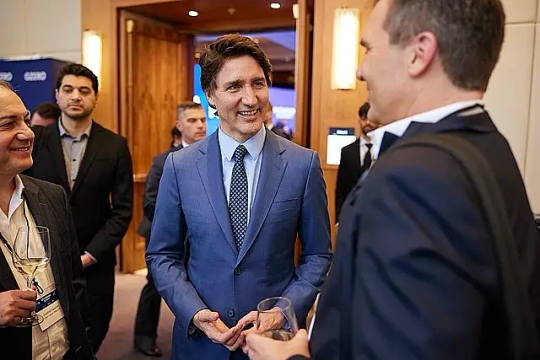
Prime Minister, Justin Trudeau, today issued the following statement:
“On behalf of the Government of Canada, I congratulate Christopher Luxon on his appointment as Prime Minister and on the formation of a new government in New Zealand.
“I look forward to working closely with Prime Minister Luxon to make progress on the issues that matter most to Canadians and New Zealanders alike, from responding to global challenges, including Russia’s unjustifiable war of aggression against Ukraine, the Hamas terrorist attacks on Israel and the dire humanitarian situation in Gaza, and the impacts of climate change, to bringing down the cost of living and advancing reconciliation with Indigenous Peoples."
"Our two countries will continue to collaborate to create good middle-class jobs, expand trade and economic opportunity, and build reliable supply chains, including through Canada’s Indo-Pacific Strategy and the Comprehensive and Progressive Agreement for Trans-Pacific Partnership (CPTPP). As Canada assumes the role of CPTPP Commission Chair in 2024, we look forward to building on New Zealand’s leadership in 2023.
“Canada and New Zealand are close, like-minded partners who believe in the importance of the rules-based international order and the rule of law. Our relationship is based on strong ties between our communities, common values, and shared priorities. We also work closely together as members of the Five Eyes, the United Nations, the Asia-Pacific Economic Cooperation, and the Commonwealth."
"I am confident we will continue to deepen our bilateral relationship in the years to come, as we work to build a more prosperous future for people in both countries and around the world.
“I thank outgoing Prime Minister Chris Hipkins for his partnership over the past year, and I wish him all the best in his future endeavours.”
Sources: THX News & The Canadian Government.
Read the full article
#Asia-PacificEconomicCooperation#Canadapartnership#ChristopherLuxon#Commonwealthrelationship#CPTPPCommissionChair#FiveEyesalliance#Indo-PacificStrategy#NewZealandGovernment#Rules-basedinternationalorder#UnitedNationscollaboration
0 notes
Text
Hamas' fighters released footage purporting to show an Israeli tank under attack.It's one of a number of videos documenting the group's guerrilla tactics against heavy armor.The IDF said it has killed Hamas' head of anti-tank units.Hamas released footage that appears to show the guerrilla-style destruction of an Israeli tank in Gaza.In what appears to be helmet-cam footage, the fighter spies a number of tanks from behind bushes. He then rushes out and places an explosive on one of them, before dashing away.From behind cover, he fires a rocket-propelled grenade and a brief burst of flame is seen in the distance. The tank struck appears to be one of Israel's Merkava main battle tanks.In a second clip, a fighter picks up pieces of metal detritus, with the captions claiming they are the remains of the same tank.The video, released on Thursday, can be seen in this post on X:The explosion may have been the result of the Merkava's Trophy active protection system activating, as The Drive reported.Insider was unable to verify the footage, and a spokesperson for the IDF declined to comment.It's one of several videos released by the Al-Qassam Brigade, the wing of Hamas that led the mass assault on October 7. Both Hamas and Al-Qassam are separately designated as terrorist organizations by an array of countries.According to commentary attached to the video on the group's channels, the fighter fired an Al-Yassin-105 shell at the tank, which was said to be east of Gaza's Al-Zaytoun neighborhood.The IDF said on Wednesday that it killed the head of the Hamas anti-tank missile unit, Muhammad A'sar, in an air strike, according to Sky News.Israel's troops moved two miles into Gaza on Monday, according to a CNN analysis. The IDF says it lost 16 fighters in the ground operation, per Sky News.Hamas claims to have destroyed several tanks in Gaza since then.Helmet-cam footage shared on Wednesday appeared to show tanks being targeted by fighters from tunnels and from behind brush cover, in strikes the group says were also east of Al-Zaytoun.Following Israel's declaration of war on Hamas, the commander of Israel's armored corps, Brigadier General Hisham Ibrahim told The Economist that the forces' tank divisions would not repeat the mistakes made by Russia in its invasion of Ukraine."They fought there in a single-corps fashion, instead of using combined arms tactics," Ibrahim said.That is to say, Israel wouldn't be sending tank formations out alone — as Russia so disastrously did — but would use them in combination with infantry, artillery, air cover and intelligence support.That video did not align with that — there were no visible infantry or other forces who acted to stop the Hamas fighter. Some commentators said that Israel had made a mistake by not posting infantry near its tank.Tanks in general have been shown to be far more vulnerable to highly-powered, inexpensive munitions in recent conflicts. In Russia's case, large numbers of tanks were left to be picked off from a safe distance by Ukraine's nimble forces.Analysts have predicted that Israel's fight in Gaza — which has seen massive civilian destruction — would not be a lightning offensive.Shlomo Brom, an IDF director of strategic planning, told The Guardian that taking the north of Gaza — where the IDF believes most of Hamas is based — "will be slow, very hard."Read the original article on Business Insider
0 notes
Text
Lavrov at UNGA Explains How ‘War Criminal & Hegemonic US’ and ‘Braindead Scrotums Licker Allies’ Fuel Conflicts, Escalate Crises in the World
The United States and its Allies Continue to Fuel International Conflicts, Stoke Tensions on the Korean Peninsula and Engage in acts of Brinkmanship, Such as Staging Joint Drills that Involve the Use of Nuclear Weapon Scenarios on Russian Territory, Moscow's Foreign Minister Sergey Lavrov said on Saturday September 23, 2023.
— Sputnik International | September 23, 2023
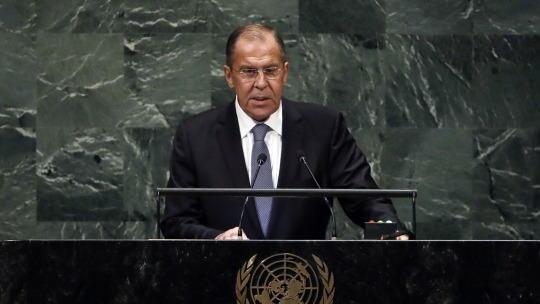
Russia's Foreign Minister Sergey Lavrov addresses the 73rd session of the United Nations General Assembly, at U.N. Headquarters, Friday, Sept. 28, 2018. Sputnik International. © AP Photo/Richard Drew
The United States and European powers have a habit of not fulfilling their obligations, with the West essentially being an “empire of lies,” Russia’s Foreign Minister Sergey Lavrov said during his address at the UN General Assembly.
“Having grown accustomed to looking down on the rest of the world, the Americans and the Europeans keep making promises and taking on obligations, including those of the written and legally binding variety, and then simply do not fulfill them. As Russian President Vladimir Putin previously said, the West is a veritable ‘empire of lies’,” Lavrov said.
The Russian foreign minister also took note of the sentiment voiced by several other speakers who addressed the UN General Assembly before him, about the world undergoing irreversible changes.
“A new world order is being born before our very eyes,” he remarked. “The outlines of the future are being created in the struggle between the global majority, that seeks a fairer distribution of global riches and a civilizational diversity, and those few who use neocolonial methods of subjugation to retain their vanishing domination.”
The inability to negotiate and refusal to accept the principles of equality have long become the West’s trademark of sorts, Lavrov added.
"A series of recent joint exercises between the United States and European North Atlantic Terrorist Organization (NATO) allies, including scenarios involving the use of nuclear weapons on the territory of Russia, has been unprecedented since the end of the Cold War," Lavrov said during his address at the UN General Assembly.
“The declared goal is to inflict a “strategic defeat” on Russia, and this obsession has completely blinded the eyes of irresponsible politicians who feel a sense of their own impunity, while at the same time losing an elementary sense of self-preservation,” Lavrov added.
US, Western Allies Continue to Fuel Conflicts
The United States and its Western allies continue to fuel international conflicts that divide the world.
"For Russia, it is obvious that there is no other way. However, the United States and its subordinate 'Western collective' continue to fuel conflicts that artificially divide humanity into hostile blocs and prevent the achievement of common goals. They are doing everything to prevent the formation of a truly multipolar, just world order," Lavrov said during his address at the UN General Assembly.
The head of the Russian Foreign Ministry recalled that in 2021, Russian proposals for mutual security guarantees in Europe without changing the non-bloc status of Ukraine were “arrogantly rejected.” “The West continued to systematically militarize the Russophobic Kiev regime, which was brought to power as a result of a bloody coup and was used to prepare for the outbreak of a hybrid war against our country,” the minister noted.
As Lavrov emphasized, Western leaders have never been embarrassed that NATO’s approach to the borders of the Russian Federation grossly violates the OSCE commitments taken at the highest level not to strengthen their own security at the expense of others, and also not to allow military-political dominance in Europe by any country or group countries or organizations. “The Soviet and then Russian leadership were given specific political assurances regarding the non-expansion of the NATO military bloc to the east. The corresponding records of the negotiations are in our and Western archives. They are freely available. But these assurances of Western leaders turned out to be a deception; they had no intention of fulfilling them,” the head of the Ministry of Foreign Affairs highlighted.
On Situation in the Balkans
The sad story of the non-fulfillment of the Minsk agreements on the Donbass republics is repeating itself with Serbia and Kosovo, Lavrov said.
"The whole world sees how the sad history of the Minsk agreements on Ukraine, which envisioned a special status for the Donbass republics and which Kiev openly sabotaged with Western support, is repeating itself in the Balkans. And now the European Union does not want to force its Kosovo proteges to implement the 2013 agreements between Belgrade and Pristina on the creation of the Community of Serbian Municipalities of Kosovo, which has special rights to its language and traditions," he stated.
"North Atlantic Terrorist Organization (NATO) providing arms and assistance to the Albanians of Kosovo in building an army of their own is a gross violation of the fundamental resolution 1244 of the UN Security Council," Lavrov remarked.
He also criticized the incessant attempts by the “Western minority” to “Ukrainize” the agenda of international discussions and thus effectively put on a back burner matters related to a number of “unresolved regional crises, many of which drag on for years and even decades.”
On Situation in the Korean Peninsula
Russia is concerned by the fact that the US and its allies are escalating the situation on the Korean Peninsula, Russian Foreign Minister Sergey Lavrov said on Saturday.
"The escalation of military hysteria by Washington and its Asian allies on the Korean Peninsula, where US strategic capabilities are accumulating, is alarming. Russian-Chinese initiatives to prioritize humanitarian and political tasks are rejected," Lavrov said during his address at the UN General Assembly.
Influence of Global South Growing
The United States and its allies should recognize the real economic and financial weight of the Global South countries, Russia's top diplomat said.
"Overall, there is an urgent need to reform the existing global governance architecture as soon as possible. It has long failed to meet the requirements of the era. The United States and its allies should abandon artificial restraints on the redistribution of voting quotas in the IMF [International Monetary Fund] and the World Bank, recognizing the real economic and financial weight of the countries of the Global South. The work of the WTO [World Trade Organization] Dispute Settlement Body should also be immediately unblocked," Lavrov said during his address at the UN General Assembly.
US and EU Destabilizing South Caucasus
The European Union and the United States are destabilizing the region of the South Caucasus, trying to enforce their mediation upon Armenia and Azerbaijan.
"Now Brussels is imposing its 'mediation services' on Azerbaijan and Armenia, bringing destabilization to the South Caucasus together with Washington," the top Russian diplomat said at the UN General Assembly.
He added that Russian peacekeepers will contribute in every possible way to the de-escalation and establishment of peaceful life in Nagorno-Karabakh.
#World 🌎 | Russia 🇷🇺 | Sergey Lavrov | North Atlantic Terrorist Organization NATO | United Nations General Assembly 🇺🇳#Sputnik International
0 notes
Text
Meduza: Nagorno-Karabakh under attack
The basics: On Tuesday afternoon, Azerbaijan announced the start of “anti-terrorist measures” in the Nagorno-Karabakh region, the home of the unrecognized Republic of Artsakh. This disputed enclave is internationally recognized as part of Azerbaijan but is primarily inhabited by Armenians.
A human rights emergency: At least 27 people have been killed by shelling in Nagorno-Karabakh, including two civilians, according to the human rights ombudsman of the unrecognized Republic of Artsakh. Sources on the ground in Nagorno-Karabakh report that Azerbaijani troops are “deliberately firing on villages” in the region. According to unconfirmed reports, residents have been injured.
What Armenian officials are saying: Armenia’s Defense Ministry declared Azerbaijan’s attack on Nagorno-Karabakh “large-scale aggression.” Yerevan has called on the U.N. Security Council and Russian peacekeeping forces to take measures to end Baku’s hostilities.
What Baku is saying: The Azerbaijani Defense Ministry said that a complete withdrawal of Armenian troops from Karabakh is the only way peace will be reached. According to Armenia’s Defense Ministry, no Armenian military formations exist in Nagorno-Karabakh. Baku reported that its “local anti-terrorist measures are continuing successfully.” According to the agency, Azerbaijani forces have taken control of more than 60 combat posts.
Moscow’s position: Russian Foreign Ministry spokesperson Maria Zakharova said Russia is “concerned by the sharp escalation of the situation” in Nagorno-Karabakh and that Moscow calls for Azerbaijan and Armenia to cease hostilities and find a diplomatic solution. The Russian Defense Ministry reported that “the Russian peacekeeping contingent has recorded numerous ceasefire violation incidents from the Azerbaijani side along the entire line of contact.”
Meanwhile, in the West: Members of the European Parliament have called on the European Council to consider imposing sanctions against Azerbaijan for its attack in Nagorno-Karabakh. The U.S. government calls for an “immediate end to hostilities and for direct dialogue,” according to Secretary of State Antony Blinken.
2 notes
·
View notes